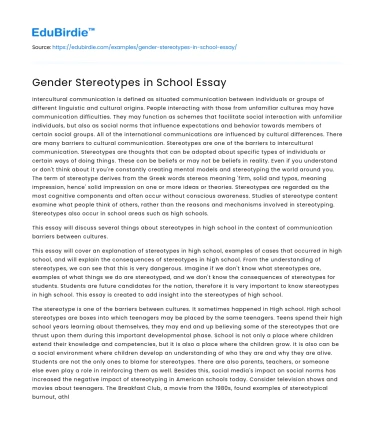Introduction
Gender stereotypes have long permeated various sectors of society, with education being no exception. These stereotypes, deeply entrenched societal norms dictating the roles and behaviors deemed appropriate for different genders, often manifest subtly yet powerfully in school settings. They influence students' academic interests, self-esteem, and future career choices, thereby reinforcing gender inequalities. As schools are pivotal in shaping young minds, they play a crucial role in either perpetuating or dismantling these stereotypes. This essay examines the persistence of gender stereotypes in educational settings, their implications on students, and strategies to combat them. By exploring real-life cases and scholarly perspectives, the argument is advanced that schools must actively work to eliminate these biases to foster an equitable learning environment. While counter-arguments suggest that gender differences may naturally manifest in educational preferences, this essay contends that such assertions often overlook the socialization processes that influence these outcomes.
Gender Stereotypes in Classroom Dynamics
In classroom settings, gender stereotypes manifest in various ways, often influencing teacher-student interactions and peer relationships. Teachers, consciously or unconsciously, may harbor biases that affect their expectations and treatment of students based on gender. For instance, research by Sadker and Zittleman (2009) indicates that teachers are more likely to call on boys than girls in math and science classes, reinforcing the stereotype that boys are more adept in these subjects. This differential treatment can lead to a self-fulfilling prophecy where students internalize these expectations, affecting their academic performance and interest. Moreover, peer dynamics in schools often reflect societal gender norms, where boys may be discouraged from expressing emotions and girls from pursuing leadership roles. A study by Francis (2010) found that girls who exhibit assertive behavior are often labeled as bossy, whereas boys displaying similar traits are considered natural leaders. These stereotypes can limit students' potential by constraining their identities and aspirations.
Save your time!
We can take care of your essay
- Proper editing and formatting
- Free revision, title page, and bibliography
- Flexible prices and money-back guarantee
Efforts to address these stereotypes must start with teacher training programs that emphasize gender sensitivity and inclusive teaching strategies. For example, implementing cooperative learning models where students of different genders work together on problem-solving tasks can help break down preconceived notions of gendered abilities. Furthermore, creating curricula that highlight contributions from both men and women in various fields can inspire all students to pursue a diverse range of interests. As educators become more aware of their biases and the impact of their interactions, they can foster an environment that encourages all students to explore their capabilities beyond traditional gender roles. Such initiatives are critical in challenging the status quo and promoting gender equity in education.
Curriculum Content and Gender Representation
The content of school curricula plays a significant role in perpetuating or challenging gender stereotypes. Historically, educational materials have often underrepresented women and marginalized groups, presenting a skewed version of history and current events. This lack of representation not only diminishes the contributions of these groups but also reinforces the notion that certain fields or roles are predominantly male or female. For instance, a study by Blumberg (2008) highlights that textbooks often depict men in active roles such as scientists or political leaders, while women are shown in passive, supportive roles. This biased representation can discourage girls from pursuing careers in science, technology, engineering, and mathematics (STEM), where female participation remains disproportionately low.
To counter these stereotypes, educational institutions must adopt curricula that reflect diversity and inclusivity. This can be achieved by integrating stories and case studies of successful women and men in non-traditional roles across various subjects. Additionally, promoting literature and media that challenge traditional gender roles can broaden students' perceptions of what is achievable. According to a report by the National Education Association (2011), schools that have implemented gender-inclusive curricula have observed a positive shift in students' attitudes towards gender roles. By presenting a balanced view of contributions across genders, schools can encourage both boys and girls to pursue their interests without the limitations imposed by stereotypes.
Impact of Extracurricular Activities on Gender Norms
Extracurricular activities in schools offer students opportunities to explore interests and develop skills outside the academic curriculum. However, these activities can also perpetuate gender norms if not carefully managed. Sports, for example, are often gender-segregated, with certain activities being stereotypically associated with boys, such as football, and others with girls, like dance. This segregation can reinforce the idea that certain skills or activities are inherently linked to gender, limiting students' willingness to engage in non-traditional pursuits. A study by Messner (2002) found that boys participating in activities like drama or choir often face social ridicule, discouraging them from exploring interests perceived as feminine.
To break these stereotypes, schools should encourage cross-gender participation in all extracurricular activities. Implementing mixed-gender teams and promoting events that highlight diverse skills can help normalize participation across traditional gender lines. Furthermore, schools can organize workshops and discussions that address the value of all activities, regardless of gender associations. By fostering an inclusive atmosphere within extracurricular programs, schools can help students develop a well-rounded skill set and challenge the gender norms that limit their potential.
Conclusion
In conclusion, gender stereotypes in educational settings present significant barriers to achieving gender equity and maximizing students' potential. These stereotypes manifest in classroom dynamics, curriculum content, and extracurricular activities, influencing students' academic interests and career aspirations. While some argue that gender differences in education reflect innate preferences, it is crucial to recognize the profound impact of socialization and cultural norms on these outcomes. By implementing strategies such as gender-sensitive teaching, inclusive curricula, and diverse extracurricular opportunities, schools can dismantle these stereotypes and promote an equitable learning environment. As educational institutions take active steps to challenge traditional gender roles, they pave the way for a more inclusive society where individuals are free to pursue their interests and talents without the constraints of outdated stereotypes.






 Stuck on your essay?
Stuck on your essay?

